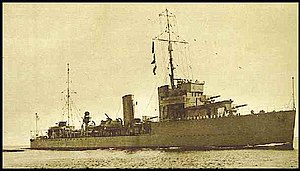 HMS Broke
| |
| History | |
|---|---|
| Name | HMS Broke |
| Namesake | Philip Broke |
| Ordered | April 1918 |
| Builder | John I. Thornycroft & Company |
| Yard number | 983 |
| Laid down | October 1918[1] |
| Launched | 16 September 1920[1] |
| Commissioned | 15 April 1925[1] |
| Renamed | From Rooke, April 1921 |
| Fate | Sunk, 8 November 1942[2] |
| General characteristics [1] | |
| Class and type | Thornycroft type destroyer leader |
| Displacement |
|
| Length | |
| Beam | 31 ft 6 in (9.60 m) |
| Draught | 12 ft 3 in (3.73 m) |
| Installed power | 40,000 shp (30,000 kW) |
| Propulsion |
|
| Speed | 36.5 kn (42.0 mph; 67.6 km/h) |
| Capacity | 500 short tons (450 t) fuel oil |
| Complement | 164 |
| Armament | 5 × BL 4.7 in (120 mm) Mark I dual purpose gun, 1 × QF 3 inch 20 cwt anti-aircraft gun,[2] 6 × 21 inch (533 mm) torpedo tubes (2 × 3) |
| Service record | |
| Part of: | 4th Destroyer Flotilla |
| Commanders: | Henry Fancourt |
| Operations: | Operation Terminal |
HMS Broke was a Thornycroft type flotilla leader of the Royal Navy. She was the second of four ships of this class that were ordered from J I Thornycroft in April 1918,[2] and was originally named Rooke after Rear Admiral Sir George Rooke of the Dutch Wars and the Battle of Vigo Bay.
The naturalist Peter Scott, among the ship's crew in 1940, conducted experiments in ship camouflage, having the two sides of Broke painted in different patterns.
- ^ a b c d Whitley 2000, p. 84
- ^ a b c Gardiner & Gray 1985, pp. 82–83